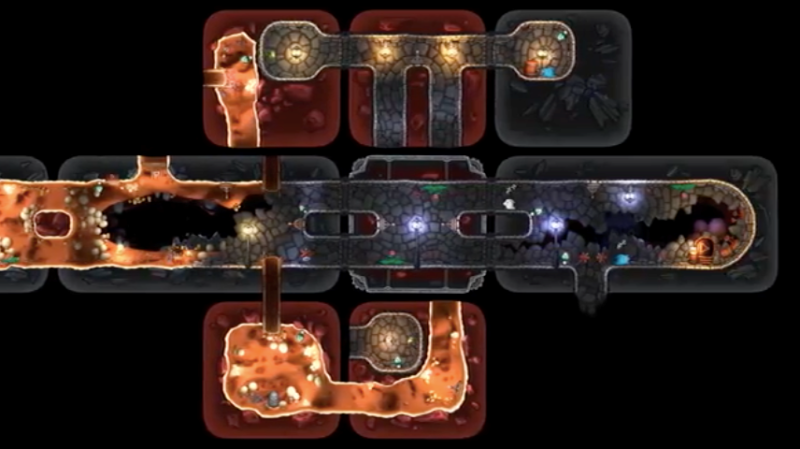
Challenging levels, intuitive controls, and charming themes are at the base of every successful puzzler. The developers of mainstays of the puzzler genre like Angry Birds, Where’s My Water?, and Cut the Rope all made sure to include these three constituent elements in their respective games, which helped bring out the best in their creations. Developer and publisher Vidroid’s new creation Molecats also features two of these core elements, as it contains fun levels and a cute theme to rival those of its competitors. However, it lacks the fluid controls requisite to contend with the puzzlers currently atop the charts.
The fictitious animals after which Molecats is named constitute the puzzler’s biggest draw. The part-cat, part-mole hybrids are so adorable that Vidroid would probably even have some success creating and selling molecat plush toys. The molecats don’t just look endearing: hearing them let loose an elongated “ooh” sound every time they arrive at a level’s exit is definitely one of the best parts of the game.

The molecats live in a world that doesn’t receive much attention at all. However, even though the storyline is almost nonexistent and is for the most part nonsensical, it does enough to get players situated in the in-game world. Molecats spend their days burrowing underground to collect items that they believe luxurious, and the game showcases this fact by presenting three molecats who want to find bits and pieces like keys and barrels. A molecat leader then comes by and shows the trio the wonders of mushrooms, and the molecats rush off to find the fungus.
The levels themselves are constructed pretty well. Unlike in many other puzzlers, each level is broken down into various tiles. Players can manipulate the tiles by turning them on their sides, which in turn opens up new pathways for their molecats to explore. In addition to maneuvering the tiles, players can have their molecats execute a variety of moves. Players start with the molecat leader Orange, who can pick up friends along the way in each level. Orange and the other molecats can run, turn around, and stop for brief periods of time. They differ in their specialized abilities, though: Orange can collect a following, some molecats can free friends from plants, and others possess totally different skillsets.

Levels are also pretty varied in terms of themes. Each level has a certain theme or introduces a particular game mechanic for players to get accustomed to. For instance, some levels may have elevators while others have chutes for molecats to parachute down. Players can also decide whether to go after the host of collectibles in each level or to just aim to make it to the level’s exit. That said, the game is certainly intended for those who possess more of a completionist mindset. In some levels, the exists are even situated right next to their entrances to highlight the fact that this game is not solely about getting from point A to point B.
Molecats also boasts an “nonfailure” gameplay style. While monsters and traps populate the different levels, they will not kill or harm players’ molecats. They’re nuisances rather than actual threats; they will not cause players to lose their progress in a given level. This means that players will have the chance to fix their mistakes, even though doing so may take a lot more time.

The warm color tone that Vidroid employs in all of the environments in Molecats really enhances their game’s appeal. In the best way possible, it makes the game’s aesthetics reminiscent of the illustrations found in a children’s book. With a wide variety of character models that players can unlock after progressing in the game and alluring backgrounds, Molecats almost possesses enough cuteness to make up for its deficiencies.
Where the game loses points is its controls. Players can flip the separate tiles on their sides by clicking on arrows situated around each tile’s corners. Even after clicking on an arrow, though, the tiles sometimes do not move. In a game where timing really matters, a few extra seconds to ensure the tile actually does flip can really set players back. Moreover, Molecats seems to punish players using a keyboard instead of a mouse. Zooming in and out doesn’t work exactly right without a mouse, which makes it difficult to keep track of one’s molecats.

And lastly, activating a molecat’s powers can be quite frustrating. Players need to select the exact tile that a molecat is currently traipsing through in order to have his or her molecat run, stop, or turn around. As soon as the molecat reaches the next tile, players need to rush to hit select the tile itself else the animal quit the action it had previously been engaged in.
Molecats is cute, challenging, and does its best to draw players in. But control issues hamper what had the potential to be even better. While Molecats is worth playing, gamers should go into it knowing that there are limitations to contend with.
Rating: 7.5/10
Check Out the Molecats Steam Launch Trailer:
Molecats is available for PC, Mac, and Linux via Steam.
Mac Review
-
Overall Score - 7.5/107.5/10
I'm a recent graduate of Columbia University. Gaming has been a passion of mine my entire life; I enjoy everything from RPGs and FPSs to stealth and narrative-driven games. I love the deeply immersive quality that good video games inherently possess, and am looking forward to highlighting games worthy of acclaim. When I'm not studying or reading, you can catch me playing games like Uncharted, Dishonored, The Witcher 3, and Far Cry.





More Stories
GTA Online: A Safehouse in the Hills Heading to PlayStation, Xbox, and PC on December 10
S.T.A.L.K.E.R. 2: Heart of Chornobyl Review for PlayStation 5
Call of Duty: Black Ops 7 and Call of Duty: Warzone Season 01 Now Live along with RICOCHET Anti-Cheat Update